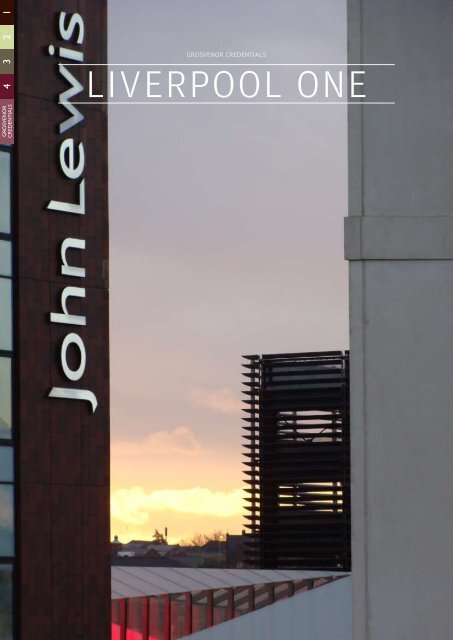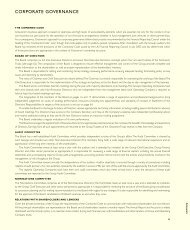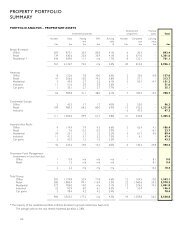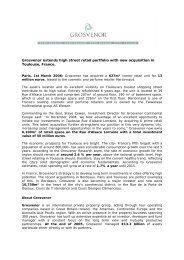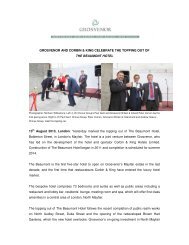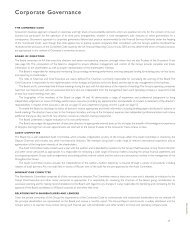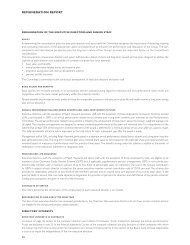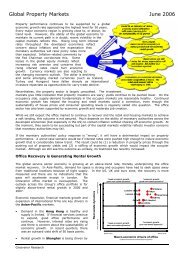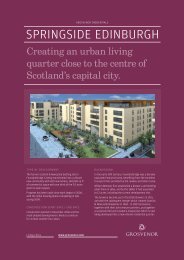liverpool one - Grosvenor
liverpool one - Grosvenor
liverpool one - Grosvenor
You also want an ePaper? Increase the reach of your titles
YUMPU automatically turns print PDFs into web optimized ePapers that Google loves.
2<br />
<strong>Grosvenor</strong><br />
credentials<br />
1<br />
3<br />
4<br />
GROSVENOR credentials<br />
<strong>liverpool</strong> <strong>one</strong>
2<br />
1<br />
3<br />
4<br />
<strong>Grosvenor</strong><br />
credentials<br />
GROSVENOR credentials<br />
<strong>liverpool</strong> <strong>one</strong><br />
Delivering a step change for<br />
Liverpool’s city centre.<br />
TYPE OF DEVELOPMENT<br />
Liverpool One is an innovative urban regeneration project<br />
that has transformed the heart of Liverpool city centre.<br />
The 42 acre site includes over 30 new buildings, 165 shops,<br />
over 500 apartments, two hotels, 25 restaurants,<br />
a 14 screen Odeon cinema, 30,000 sq ft of offices, a<br />
revitalised five acre park, 3,000 car parking spaces and<br />
a public transport interchange.<br />
BACKGROUND<br />
In the 18th century the 42 acres of Liverpool city centre,<br />
which is now known as Liverpool One, was the home of the<br />
UK’s first dry dock and the linchpin of Liverpool’s booming<br />
maritime trade with the rest of the world. The decline in<br />
Liverpool as a maritime trading city is well documented<br />
and during the post Second World War period Liverpool<br />
fell into steep decline. The area which was later to become<br />
known as the Paradise Street Development Area (PSDA) and<br />
now home to Liverpool One, suffered heavy bombing during<br />
the war and through lack of investment, remained an area in<br />
need of regeneration.<br />
The steady decline in population over several decades was<br />
a major contributor to the under-investment in Liverpool’s<br />
retail offer. Numerous studies on behalf of the city council<br />
by <strong>Grosvenor</strong> and others showed that consumers preferred<br />
to shop in Manchester, Chester and Southport rather than<br />
go to Liverpool. <strong>Grosvenor</strong> and other experts in the industry<br />
estimated that for a city the size and importance of Liverpool,<br />
it was short by about <strong>one</strong> million sq ft of retail space.<br />
The best place to build this extra retail was universally<br />
recognised to be within the PSDA as it would achieve a<br />
number of objectives, namely: it would extend the existing<br />
city retail offer and create links to the Albert Dock,<br />
reconnecting an important area of the city; it would also link<br />
to the Ropewalks which had underg<strong>one</strong> development into a<br />
vibrant arts quarter; most importantly, it was <strong>Grosvenor</strong>’s<br />
view, and <strong>one</strong> shared by many, that retail-led mixed-use<br />
regeneration could lead an urban renaissance in Liverpool<br />
bringing people back to the city - a trend that elsewhere by<br />
the 2000s was already on the rise.
2<br />
4<br />
<strong>Grosvenor</strong><br />
credentials<br />
1<br />
3<br />
GROSVENOR credentials<br />
KEY SUCCESS MEASURES<br />
• In 1970 Liverpool was third amongst prime shopping<br />
locations. By 1995 it was 17th. Current research by<br />
Experian now places Liverpool at fifth with the bounceback<br />
being attributed to Liverpool One (source:<br />
Experian).<br />
• 5,000 new jobs have been created.<br />
• A key objective behind the development of Liverpool One<br />
was to increase overall footfall into the city rather than<br />
Liverpool One cannibalise other parts of the city centre<br />
retail offer. Research shows that city footfall on average<br />
increased by 17% the year Liverpool One opened and by<br />
an additional 4.5% in 2009 (source: Liverpool City Centre<br />
BID).<br />
• Church Street (a prime shopping street now linked with<br />
Liverpool One) experienced a 50% increase in footfall<br />
in December 2008 (source: Liverpool City Centre BID).<br />
• Since Liverpool One opened, the Albert Dock (also now<br />
linked to the city centre via Liverpool One) has seen an<br />
extra 100,000 visitors per week, which is an impressive<br />
48% increase overall (source: Liverpool City Council).<br />
• Liverpool One has received over 20 industry awards<br />
to date, including the RICS Regeneration of the Year<br />
Award 2009, BCSC Supreme Award 2009 and being the<br />
first masterplan to be nominated for the Stirling Prize.<br />
Liverpool One has acted as a catalyst for improvements in the<br />
area and will continue to do so for many years to come.<br />
In January 2010, Liverpool Vision (a partnership between<br />
Liverpool City Council, the Homes and Communities<br />
Agency and NWDA) reported a further £900m of city wide<br />
development was either on site or in the pipeline (with<br />
planning permission granted).<br />
TARGET MARKET<br />
Liverpool One’s catchment of 4.7 million people has an annual<br />
available spend of £11.5bn, including £3.1bn on<br />
clothing and footwear. Liverpool previously attracted 557,000<br />
regular shoppers, making it the second largest market in the<br />
north west and the eighth largest in the UK as a whole. With<br />
the opening of Liverpool One, this has risen to 600,000<br />
regular shoppers, and fifth in the country. This rise in ranking<br />
is attributable to the spending power of Liverpool’s catchment,<br />
the fifth largest in the country, which has been drawn in by<br />
Liverpool One.<br />
An important target market is the secondary catchment and<br />
consumers that live in the areas such as the Wirral, Chester,<br />
and Southport.<br />
Stakeholders / Partners<br />
<strong>Grosvenor</strong> was selected by Liverpool City Council as the<br />
preferred developer for PSDA. <strong>Grosvenor</strong> is a key<br />
investor in the project, along with a consortium of other<br />
investors. These include Hermes, Redevco and Liverpool<br />
Victoria, and the leading banks are RBS, Barclays, HSBC<br />
and Eurohypo.
2<br />
1<br />
3<br />
GROSVENOR credentials<br />
4<br />
<strong>Grosvenor</strong><br />
credentials<br />
Deal Structure<br />
Head lease from Liverpool City Council.<br />
Ownership<br />
<strong>Grosvenor</strong> Liverpool Fund.<br />
Method of funding<br />
The <strong>Grosvenor</strong> Liverpool Fund is a UK Limited Partnership<br />
comprising equity from eight investors and debt from a<br />
syndicate of four leading banks. Liverpool One is an entirely<br />
private sector funded development and, as such, no grants<br />
were received.<br />
Issues Resolved<br />
<strong>Grosvenor</strong>’s biggest challenge was to deliver Liverpool<br />
One during 2008, Liverpool’s Capital of Culture year. This<br />
meant <strong>Grosvenor</strong> and its partners would need to deliver the<br />
development in just four years. Other difficulties that<br />
had to be overcome included:<br />
• Dealing with land acquisition which required negotiation<br />
on 275 interests across the 42 acre site.<br />
• Masterplanning: a key objective of the masterplan was<br />
to link different areas of the city such as the Ropewalks,<br />
the waterfront, existing retail areas and the city’s business<br />
district, as well as being a destination in its own right.<br />
• Co-ordinating the work of 26 firms of architects.<br />
• Relocation of essential services before works could start<br />
including: building a new bus station; relocation of BBC<br />
Radio Merseyside to purpose built studios on Hanover<br />
Street; and, relocation of the fire station to St Anne Street.<br />
• The site is also adjacent to a World Heritage Site which<br />
created challenges with the residential tower<br />
(One Park West), designed by Cesar Pelli. English<br />
Heritage was concerned that the building would be<br />
too tall. The design was eventually reduced by three<br />
floors to satisfy concerns.<br />
• The development agreement called for a comprehensive<br />
redevelopment of the 42 acre site. This required a singlephased<br />
development solution rather than a multi-phased<br />
approach which would have taken many years to deliver.<br />
This created challenges in terms of cost and the construction<br />
programme. Despite this, Liverpool One was delivered as<br />
promised by <strong>Grosvenor</strong> in four years with virtually no<br />
deviation from the original masterplan.<br />
Environmental management<br />
An innovative bio-diesel processor converts used cooking<br />
oil from the restaurants to run all on-site vehicles. The<br />
bio-diesel processor can create 1,700 litres of fuel every<br />
month saving the equivalent of 53,000 kg CO 2 a year.<br />
Construction Start date/End date<br />
• Start on-site: November 2005.<br />
• Phase I opening: May 2008 (streets and <strong>one</strong> million<br />
sq ft of retail).<br />
• Phase II opening: October 2008 (restaurants, cinema,<br />
park and remaining retail space).<br />
TEAM INVOLVED<br />
The complexity of generating and delivering a masterplan for<br />
the area was such that a large team of specialist<br />
consultants was assembled over a period of four years.<br />
Core Masterplanning Team<br />
• <strong>Grosvenor</strong><br />
• Nightingale Associates,<br />
• Building Design Partnership, access consultants<br />
masterplanners<br />
• Pelli Clarke Pelli, urban<br />
• Capita Symonds, highway design consultants<br />
designers and health and • Waterman Partnership,<br />
safety advisors<br />
structural and<br />
• Davis Langdon,<br />
environmental engineers<br />
cost consultants<br />
• WSP Group, infrastructure<br />
• Drivers Jonas,<br />
and building services<br />
planning consultants engineers<br />
• Liverpool City Council<br />
Property / Planning Consultants<br />
• CBRE<br />
• Cushman & Wakefield<br />
• Edmund Kirby<br />
Legal Teams<br />
• Allen & Overy<br />
• Berwin Leighton Paisner<br />
• Boodle Hatfield<br />
• Brabners Chaffe Street<br />
Contractors<br />
• Balfour Beatty, east of<br />
Paradise Street<br />
• Kier, Hilton Hotel<br />
Architects<br />
• Aedas<br />
• Allies & Morrison<br />
• Austin Smith Lord<br />
• BDP<br />
• Brock Carmichael<br />
• Craig Foster Architects<br />
• CZWG<br />
• Dixon J<strong>one</strong>s<br />
• FAT<br />
• Glenn Howells<br />
• Greig & Stephenson<br />
• Gross Max<br />
• Groupe Six<br />
• Hawkins Brown<br />
• Haworth Tompkins<br />
• Keppie Massie<br />
• Strutt & Parker<br />
• Tushingham Moore<br />
• Denton Wilde Sapte<br />
• Nabarro<br />
• Slaughter & May<br />
• Laing O’Rourke, west<br />
of Paradise Street<br />
• Mansell, Site 8<br />
• John McAslan & Partners<br />
• Leach Rhodes Walker<br />
• Limbrick Architecture<br />
& Design<br />
• Marks Barfield<br />
• Michael Squires & Partners<br />
• Owen Ellis Partnership<br />
• Page & Park<br />
• Pelli Clarke Pelli<br />
• Stephenson Bell<br />
• Studio Three<br />
• Wilkinson Eyre<br />
Living cities<br />
www.grosvenor.com


